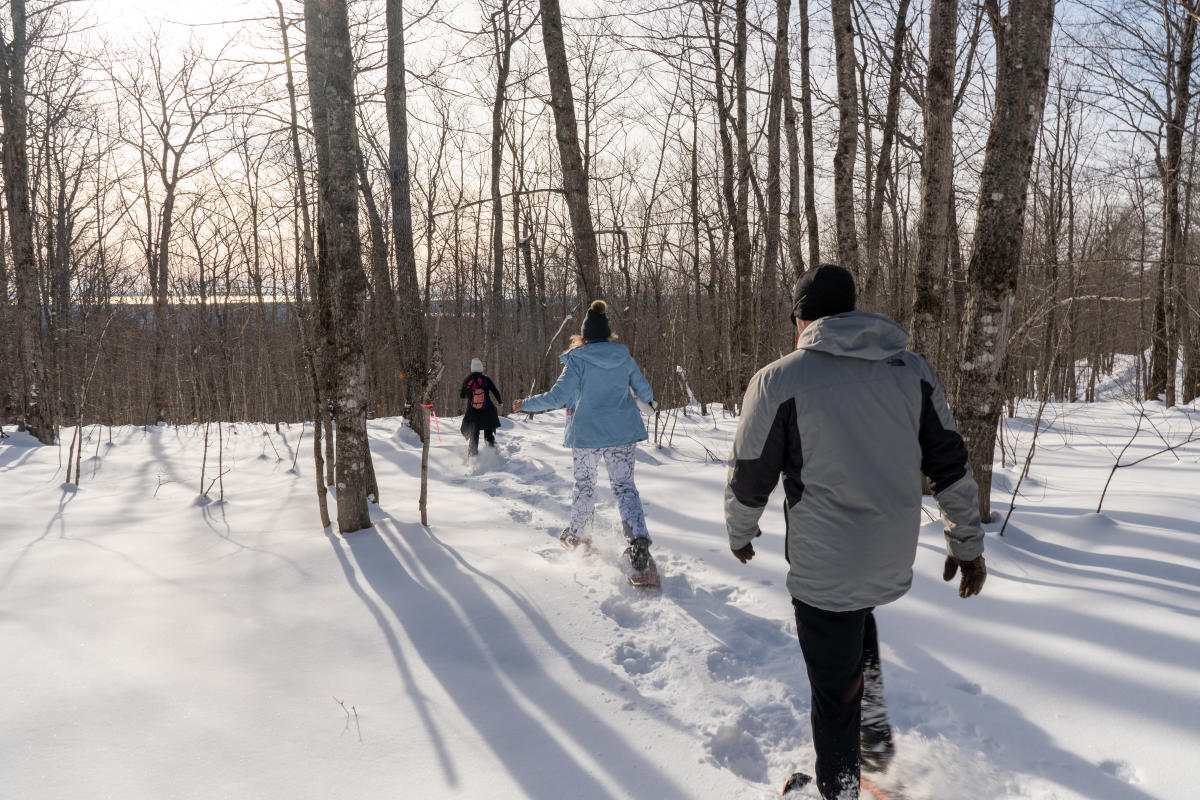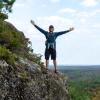It’s no secret that we take pride in our winters in the Keweenaw. We’ve got multiple ski hills, a Snow Thermometer, several dozen miles of XC trails, some of the best snowmobile trails in the Midwest, and even a week-long Winter Carnival! It seems no matter where you look, there’s something fun to do throughout the Keweenaw’s lengthy snow season.
That begs the question: how do you start to deal with 300”+ of snow? If you’ve wondered how we handle more of the white stuff than almost anywhere else east of the Rockies, we’ve got the (Yooper) scoop for you!
How Much Snow Does the Keweenaw Really Get?
When you stare up in awe at the Keweenaw’s Snow Thermometer, it’s easy to imagine our 300”+ of snow piling up higher than homes and entombing forests whole. The truth isn’t quite that scary. Although we really do receive nearly two dozen feet of snow on average each year, it’s never all at once. Between occasional melts during warm spells and the compression of light and fluffy snow, we typically only reach 3’-5' of snowpack on the ground at winter’s peak. That’s still formidable but is much easier to snowshoe through!

Lake Superior helps generate a lot of lake effect snow.
Even in the Keweenaw, where you’re located makes a big difference in how much snow you’re bound to get. Higher terrain usually receives more than areas near the lake. High-wind areas often get scoured clean, while woodlands pile it on in huge drifts. Combine these natural forces and you’ve got a recipe for heavy snowfall in places like the Delaware Mine Location and Calumet, and a lot less for the ‘banana belt’ of Chassell and Baraga.
If you’re looking for good resources to track how much snow we’ve gotten, here are two of our most trusted sources. Keep in mind they’re not always the same. This is typically down to location and methodology, as mentioned above.
When Does it Start/Finish Snowing?
It depends! There are apocryphal tales of snow falling in the Keweenaw at any month of the year. In reality, we typically see our first snowfall in mid to late-October, with significant accumulations beginning in November. Snow season usually ends in late-April to early-May, although deep drifts often hang on into June on ski hills and in forested areas.
Remember that these are based on average climatic conditions. It’s not unheard of for our first snowfall to arrive in September, although any snow this early is more of a warning shot than anything because it is still far too warm for it to stick around. It also has been known to quit snowing in March one year and drag into Memorial Day the next. Moral of the story: don’t put away your shovel too early!

We typically only reach 3’-5' of snowpack on the ground at winter’s peak, perfect for outdoor activities like fat-tire biking.
The Lake Effect Snow Machine
The bulk of our snowfall comes as Lake Effect Snow, or LES for short. LES forms when there’s a difference in temperature between Lake Superior and the ambient air. As cold air filters down from the Arctic and crosses the warmer waters of the lake, it picks up evaporating moisture which forms dense bands of clouds that make a beeline for land. When the warm, humid air and clouds rise, they dump their moisture as either rain or snow depending on how cold it is. The bands of clouds don’t always hit everywhere equally. If the wind is locked in just right, it could be sunny in one spot all day and snowy just a few miles up the road!
It’s not uncommon for LES to start and never really stop. It’ll snow consistently all day and into the night, with only brief breaks as the winds shift the cloud bands to different areas. It’s common for LES to come down at a pace of 1” - 3” an hour!
Enter the Lake Effect Snow Machine. It’s a nearly unlimited source of enjoyment or toil depending on your perspective. Early in the season we crave it, but by February we’re wondering when it’ll shut down. The only way to kill the Lake Effect Snow Machine is for the lake to start freezing over (essentially putting a lid on the lake below), or air temperatures to rise. Otherwise, if a cold wind blows across the warmer lake, snow is bound to follow.

If Lake Superior freezes over, lake effect snow will diminish.
Lake Effect Snow happens across the Great Lakes, from the Keweenaw to Buffalo, NY. It can even happen on smaller inland lakes before they freeze over. Tiny, localized snow belts can set up anywhere if conditions are right!
The Keweenaw also gets system snow from normal weather patterns that hit the region. This snow is heavier and often comes all in one big blast. These storms are similar to Nor’easters, often dropping over a foot of snow at one time depending on their severity. In our case, a big system will barrel through and quickly be followed by another round of lake effect, adding insult to injury. Two storms for the price of one!
All That Snow Has to Go Somewhere…
Every community, home, and business has a plan for dealing with the snow. How do we know? Just ask ‘em and they’ll tell you! Each tier has the same concern: how to efficiently move the snow as quickly as possible, while at the same time preparing for the next wave.
At the community level, every city, township, village, and road commission in the region has a literal fleet of equipment to move the snow around. Plow trucks are the gold standard. Most come with dump beds for distributing a blend of sand (traction) and salt (ice melting) depending on the temperature. A few plow trucks are pure muscle and are used solely for blasting open drift-covered roads after each and every storm.

Our Keweenaw road commissions know how to clear snow!
Next, front end loaders for picking up and removing big piles of snow from tight city streets. These are fairly standard to see running around clearing the way. Most communities have at least one. A little less common but even more useful for big jobs are road graders. These mammoth machines can rip up the densest mats of ice and snow and push aside snow drifts with ease.
Last but not least, we’ve saved the most interesting and legendary snow-busting machine for last: The SnoGo. Only the luckiest communities have one of these bad boys, and it’s easy to see why. Unlike the rest of the equipment on this list that can be used year-round, the SnoGo has one purpose, and that is to THROW SNOW! These super-sized snow blowers are used to chew straight through the biggest piles of snow with ease, either shooting it incredible distances or directing it straight into an awaiting dump truck for disposal elsewhere. Modern versions are mounted on front end loaders, while a few vintage machines are simply a truck with giant augers on the front and nothing more. They are chilling in their efficiency and a sight to behold when they are deployed. Check out Keweenaw County’s newest SnoGo in action here.
Getting the snow out of the way is all well and good until you run out of places to put it. City streets quickly become clogged and residential neighborhoods become full of sky-high stacks of frozen accumulation. Using a combination of dump trucks, loaders, and SnoGos, these piles are hauled to designated snow storage areas for ‘safekeeping.’ It is these areas where you’re most likely to find the latest snow in the Keweenaw (even rivaling the Mont Ripley glacier!) as the snow melts slowly away out of sight.
When all else fails, every home has a secret weapon: the Yooper Scoop. Technically ‘just’ a snow scoop, this ingenious device slides along the ground and allows you to easily move significant quantities of snow without breaking your back. Push your scoop into the snow, rock it back to free a load, slide it to where you want to dump it, and away you go. Get your own Keweenaw-made Yooper Scoop and discover what you’ve been missing!
Do They Cancel School?
Despite being snowy for half the school year, our local K-12 schools are resilient and don’t cancel classes as often as you’d think. The Keweenaw’s road commissions are experts at clearing snow and can tackle a typical overnight LES accumulation with ease (potentially up to several inches). We might get a 2-hour delay during bigger storms to give them more time to get caught up. Only during the snowiest storms do schools shutter for the day.
Classes aren’t usually canceled due to snow alone. High winds contribute to low visibility during snowstorms and can drive wind chills well below 0°F, both of which boost the danger level significantly. Days like that are not safe for students to wait long for the bus or parents driving kids to school. We might be hardy, but we know when to call it quits and stay home.
Michigan Tech, on the other hand, often goes years without canceling classes. There have been so few closures at Michigan Tech over the years that they’ve compiled a list of them. Each is a tale of a particularly legendary blizzard that completely shut down the Keweenaw.
How to Prepare For Your Trip
One of the most important things to keep in mind during your winter travels is to be flexible and patient. During big snowstorms we try our best to dig out quickly, but sometimes businesses delay their openings or have to close for the day. Safety always comes first! Whether you ski, snowmobile, fat bike, or snowboard, it might take a little while to groom the trails after a big storm (not a problem for Mt. Bohemia, of course). Rest assured, we’re as excited as you are to finally get caught up. Keep an eye on our Visit Keweenaw Snowfall & Trail Report for updates!
Winter temperatures are usually milder in the Keweenaw thanks to the moderating effect of Lake Superior. You’ll still want to pack warm jackets and many layers of clothing in case you get too warm out snowshoeing or sightseeing. Believe us, it’s easy to bundle up a little too much.

Dress in layers for activities like snowshoeing.
When all else fails, there are plenty of indoor activities to explore during the winter if the weather is too inclement out there. After it clears up though, we look forward to seeing you out there!
Interested in updates, travel tips and quirky information about the Keweenaw? Just sign up for the Keweenaw Explorer, our monthly e-newsletter. Complete the form…

